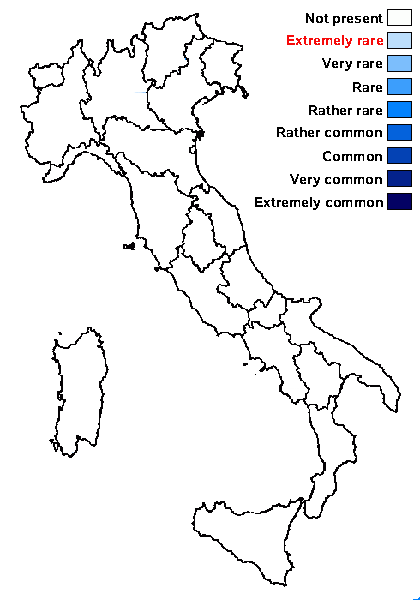Micarea pusilla Launis, Malíček & Myllys
in Launis & al., Mycologia, 111, 4: 587, 2019.
Synonyms:
Distribution:
Description: Thallus crustose, thinly episubstratic, whitish green to olive green, usually inconspicuous, composed of 20-35 µm wide goniocysts that are often aggregated into larger units. Apothecia micareoid, emarginate, usually crowded, very small, (0.07-)0.1-0.15(-0.2) mm across, white or cream-white, convex to hemispherical, not tuberculate. Proper exciple poorly developed, usually indistinct; epithecium colourless, without crystals, K-; hymenium colourless, without crystals, c. 30-35 µm high; paraphyses branched and anastomosing, 0.5-1 thick; hypothecium colourless. Asci 8-spored, clavate, , with a K/I + pale blue apical dome with a dark blue tubular structure, 16-25 x 7-8 µm. Ascospores simple or 1-septate, hyaline, oblong-ellipsoid or obovoid, 7-9(-9.5) x 2-3 µm. Pycnidia whitish, K- and C-., of two types: a) mesopycnidia sessile or mostly immersed, 30-70 µm wide, producing fusiform, narrowly ellipsoid to cylindrical mesoconidia measuring 4-4.5(-5) x 1-1.5 µm, b) micropycnidia mostly immersed, 30-50 µm wide, producing bacilliform or narrowly fusiform microconidia measuring (5-)5.5-7(-7.5) x c. 1 µm. Photobiont micareoid, the cells 4.5-7 µm wide. Spot tests: thallus K-, C-, KC-, P-. Chemistry: methoxymicareic acid.Note: a recently-described species growing on decaying wood, more rarely on acid bark, known from Northern and Central Europe, the Caucasus and Dagestan, but perhaps more widespread, being very easily overlooked (Launis & al. 2019). To be looked for in the Italian Alps.
Growth form: Crustose
Substrata: bark and lignum
Photobiont: green algae other than Trentepohlia
Reproductive strategy: mainly sexual

Predictive model
Growth form: Crustose
Substrata: bark and lignum
Photobiont: green algae other than Trentepohlia
Reproductive strategy: mainly sexual

Predictive model

